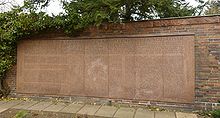Elvira Eisenschneider
Elvira Eisenschneider (born April 22, 1924 in Fischbach ; † April 6, 1944, presumably in Sachsenhausen concentration camp ) was a German resistance fighter .
Life
As the daughter of Paul Eisenschneider , when she was ten, she and her mother Ella had to flee to the nearby autonomous Saar area in 1934 , where her father had been since 1932. On March 7, 1933, during a house search for Elvira's father, the mother was so badly mistreated that she was permanently damaged. In autumn 1936 the family came to the Soviet Union via France and Great Britain . While Elvira's father returned to Germany for illegal work after attending the International Lenin School in Moscow in 1936 and was arrested in November 1936 and later sentenced to life imprisonment, her mother was taken care of by Soviet doctors and she herself was sent to the international children's home Ivanovo . Here she became a Komsomol member and was preparing to study at the Institute of Literary Studies in Moscow.
After the attack by the Wehrmacht on the Soviet Union, Eisenschneider trained as a medic and accompanied an evacuation transport from Moscow to Chelyabinsk in autumn 1941 . She also gave German lessons to Soviet officers. In 1942, after her 18th birthday, she volunteered for the Red Army . She received training as a parachutist and scout and took on some partisan missions behind the front. In the summer of 1943 she parachuted from behind the front in Germany. She is said to have managed to get to the Palatinate, at least some of her radio messages were documented from there. On February 23, 1944, she was arrested in the Ruhr area and shot in a concentration camp on April 6, 1944.
Honors
- The names of Elvira Eisenschneider and her father Paul Eisenschneider are engraved on the large plaque of the memorial of the socialists in the Berlin central cemetery Friedrichsfelde in the Lichtenberg district .
- In 1961 the German Post of the GDR issued a special stamp in honor of Elvira Eisenschneider.
- The ROS 404 Elvira Eisenschneider was in service from September 30, 1966 to May 1987. It was a feeder trawler of the "Artur Becker" series .
literature
- Luise Kraushaar (Ed.): German resistance fighters 1933-1945. Biographies and letters . Volume 1. Dietz, Berlin 1970, pp. 220-222.
- Dieter May: Paul and Elvira Eisenschneider - Two forgotten resistance fighters against National Socialism . In: Heimatkalender des Landkreis Birkenfeld 1987. Contributions to the past and present of the country on the upper Nahe, the Westrich, the Hoch- and Idarwald , pp. 134-139.
- Karl Heinz Jahnke : In one front: Young Germans on the side of the Soviet Union in the Great Patriotic War . Military publishing house of the GDR, Berlin 1989, ISBN 3-327-00732-2 .
- Luitwin Bies: Paul, Ella and Elvira. About the life of the Eisenschneiders from Fischbach an der Nahe. Ed .: Alternative list of the district of Birkenfeld. Idar-Oberstein 2001 ( book review on the website of the German Resistance Study Group 1933–1945 )
- Simone Barck , Anneke de Rudder, Beate Schmeichel-Falkenberg (eds.): Century fates. Women in exile in the Soviet Union. 1st edition. Lukas Verlag, Berlin 2003, ISBN 3-931836-93-2 .
- Peter Rau: "So that our dreams come true." Elvira Eisenschneider wanted to help speed up the end of the war . In: Information DRAFD, December 2004 (PDF; 635 kB), p. 9f.
Individual evidence
- ↑ Jahnke writes that Elvira was "probably murdered in 1944". Kraushaar remarks that she was discovered and arrested in the spring of 1944 and that she has been missing since then. DRAFD Information reports that in a commemorative publication for the 125th anniversary of the Göttenbach-Gymnasium (1997) in Idar-Oberstein, which Paul Eisenschneider had once attended, the Oranienburg (Sachsenhausen?) Concentration camp is named as the last stage of his daughter's life: she was arrested in February 1944 in the Ruhr area and murdered on April 6th. The same statements can be found in an article by Dieter May in the 1987 home calendar of the Birkenfeld district (see literature).
- ↑ Information with technical data
- ^ Photo of the ship ( memento from July 20, 2012 in the Internet Archive )
| personal data | |
|---|---|
| SURNAME | Eisenschneider, Elvira |
| BRIEF DESCRIPTION | German resistance fighter |
| DATE OF BIRTH | April 22, 1924 |
| PLACE OF BIRTH | Fischbach |
| DATE OF DEATH | April 6, 1944 |
| Place of death | Sachsenhausen concentration camp |
